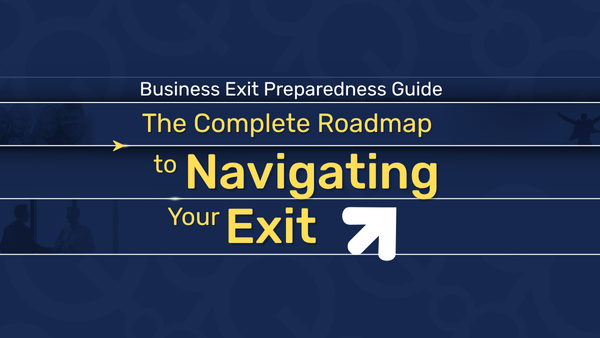Most business owners obsess over EBITDA multiples, assuming that higher earnings automatically translate to hidden value in their business. But here’s what investment bankers won’t tell you upfront: two identical companies with the same EBITDA can sell for vastly different prices—sometimes 2x to 3x apart.
The difference? Hidden value drivers that sophisticated buyers recognize but most sellers never optimize.
The EBITDA Trap: Why Numbers Tell Half the Story

Michael’s manufacturing company generated $2.8M in EBITDA—solid numbers in his industry. But when he went to market, buyers offered only 4x multiples while his competitor down the street had recently sold for 7x. Same industry, similar financials, dramatically different outcomes.
The competitor had something Michael’s business lacked: predictable, defendable value that buyers could bank on. EBITDA showed what happened last year; these hidden value drivers predicted what would happen next year.
Hidden Value Driver #1: Customer Acquisition Predictability

What Buyers Really Want to Know: Can this business reliably generate new customers without the current owner’s personal relationships?
The Difference Makers:
- Systematic Lead Generation: Companies with documented, repeatable marketing systems command premium multiples. Buyers pay more for businesses where customer acquisition is a process, not a personality.
- Conversion Rate Optimization: A landscaping company that converts 45% of estimates versus the industry average of 25% has a competitive moat. Buyers recognize this operational advantage translates to sustainable profits.
- Customer Lifetime Value Metrics: Businesses that can demonstrate increasing customer value over time—through upselling, cross-selling, or retention—prove their revenue streams are expanding, not just maintaining.
Red Flag for Buyers: When 80% of new business comes from the owner’s personal network, referrals, or industry reputation. This creates “key person risk” that destroys value.
Value Multiplier: Companies with systematic customer acquisition often sell for 2-3x higher multiples because buyers can confidently project future growth.
Hidden Value Driver #2: Operational Resilience

What Buyers Really Want to Know: Will this business maintain performance if key people leave, supply chains shift, or market conditions change?
The Difference Makers:
- Process Documentation: Every critical function—from sales to delivery to customer service—has written procedures that any competent employee can follow. Buyers pay premiums for businesses that don’t require tribal knowledge.
- Vendor Diversification: Multiple suppliers for critical inputs, established relationships with backup vendors, and contracts that protect against price volatility. Single-source dependencies terrify buyers.
- Quality Control Systems: Consistent output regardless of who’s working. A restaurant chain with standardized recipes and training programs versus a chef-driven establishment—buyers know which one scales.
Red Flag for Buyers: When the business depends on the owner’s personal expertise, relationships, or daily decision-making. “I handle all the customer calls” is a valuation killer.
Value Multiplier: Operationally resilient businesses often attract strategic buyers who pay premium multiples because they can immediately integrate the company into their existing operations.
Hidden Value Driver #3: Market Position Sustainability

What Buyers Really Want to Know: Can this business defend its market share against competitors, and ideally grow it?
The Difference Makers:
- Switching Costs: Customers who would face significant time, money, or disruption costs to change providers. A software company with integrated workflows versus a commodity service provider.
- Network Effects: Businesses that become more valuable as they gain more customers. A logistics company whose route density creates efficiency advantages, or a platform where more users attract more users.
- Regulatory Advantages: Licenses, certifications, or compliance requirements that create barriers to entry. A waste management company with hard-to-obtain permits versus a general contractor.
Red Flag for Buyers: Competing primarily on price in a commoditized market with low barriers to entry. These businesses face constant margin pressure and limited growth potential.
Value Multiplier: Sustainable competitive advantages often trigger bidding wars between strategic buyers, driving multiples well above industry averages.
The Compound Effect: When All Three Align

Here’s the challenge: these hidden drivers can’t be created overnight. They require 12-24 months of focused development, which means the time to start building them is now—not when you’re ready to sell.
Start with the most broken: Which of these three areas currently represents the biggest risk to your business? Address that weakness first.
Document everything: Begin systematizing the processes that currently exist only in your head or in informal team knowledge.
Measure what matters: Track the metrics that demonstrate these value drivers—customer acquisition costs, employee productivity, market share indicators.
The Strategic Advantage

Businesses that optimize these hidden value drivers don’t just sell for higher multiples—they attract better buyers, negotiate from positions of strength, and often receive multiple offers that create competitive bidding.
More importantly, building these strengths makes your business more profitable and less stressful to run while you still own it. The same factors that buyers value are the ones that create sustainable competitive advantages.
The most successful exits aren’t just about hitting EBITDA targets—they’re about building businesses so fundamentally strong that buyers compete to own them. Start building these hidden value drivers today, and when you’re ready to sell, you won’t just be selling profits—you’ll be selling a platform for future growth.







